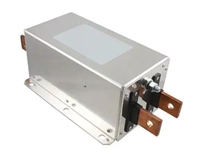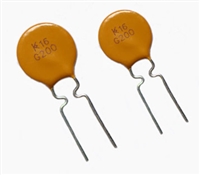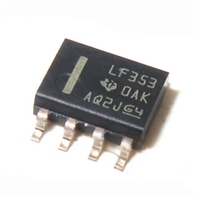Description of terms
1. Spectral response
7. Interelectrode resistance: Rie
The photocurrent produced by a given level of incident
light varies with the wavelength. This relation between
the photoelectric sensitivity and wavelength is referred to
as the spectral response characteristic and is expressed
in terms of photo sensitivity, quantum efficiency, etc.
This is the resistance between opposing electrodes in a
dark state. The interelectrode resistance is an important
factor that determines the response speed, position res-
olution and saturation photocurrent.
The interelectrode resistance is measured with 0.1 V ap-
plied across the opposing electrodes and the common
electrode left open. When measuring the interelectrode re-
sistance of two-dimensional PSDs, the output electrodes
other than the opposing electrodes under measurement
are left open.
2. Photo sensitivity: S
This measure of sensitivity is the ratio of radiant energy
expressed in watts (W) incident on the device, to the re-
sulting photocurrent expressed in amperes (A). It may be
represented as either an absolute sensitivity (A/W) or as
a relative sensitivity normalized for the sensitivity at the
peak wavelength, usually expressed in percent (%) with
respect to the peak value. For the purpose of our PSD
data sheets (separately available), the photo sensitivity
is represented as the absolute sensitivity, and the spec-
tral response range is defined as the region in which the
relative sensitivity is higher than 5 % of the peak value.
8. Dark current: I
D
When a reverse voltage is applied to a PSD, a slight cur-
rent flows even in a dark state. This is termed the dark
current and is a source of noise. The dark current listed in
our PSD data sheets (separately available) are the total
dark current values measured from all output electrodes.
9. Terminal capacitance: Ct
3. Quantum efficiency: QE
A capacitor is formed at the PN junction of a PSD and its
capacitance is called the junction capacitance. The ter-
minal capacitance is the sum of the junction capacitance
plus the package stray capacitance, and is a factor in
determining the response speed. The terminal capaci-
tance listed in our PSD data sheets are the total capaci-
tance values measured from all output electrodes.
The quantum efficiency is the number of electrons or
holes that can be detected as a photocurrent divided by
the number of the incident photons. This is commonly
expressed in percent (%). The quantum efficiency and
photo sensitivity S have the following relationship at a
given wavelength (nm):
S × 1240
QE =
× 100 [%]
10. Rise time: tr
λ
The rise time is defined as the time required for the PSD
output to rise from 10 to 90 % of the steady output level,
when a step function light is input to the PSD. The rise
time depends on the incident light wavelength, load
resistance, light incident position and reverse voltage,
and is measured under the following conditions.
λ: Wavelength (nm)
S: Photo sensitivity at wavelength λ (A/W)
4. Resistance length: L
This is the distance between electrodes on a PSD and is
used to calculate the position from the PSD outputs. The
resistance length is equivalent to the active area size,
except for the pin-cushion type (improved tetra-lateral
type) whose resistance length is expressed by the
distance actually used to calculate the position.
· Light source
· Incident spot light
: λ=890 nm
: φ1 mm
· Incident light position: Center point of PSD
· Load resistance : 1 kΩ
(connected to all output electrodes)
5. Position detection error
If a light beam strikes the electrical center of a PSD, the sig-
nal currents extracted from the output electrodes are equal.
When this electrical center is viewed as the origin, the posi-
tion detection error is defined as the difference between the
position at which the light is actually incident on the PSD
and the position calculated from the PSD outputs. Measure-
ment conditions for position detection error are as follows:
11. Saturation photocurrent: Ist
This is the maximum photocurrent value obtained from a
PSD as long as it still functions as a position sensor.
This value depends on the reverse voltage and interelec-
trode resistance, and is defined as the total photocurrent
when the entire active area is illuminated.
Light source
Incident spot light: φ200 µm
Photocurrent : 10 µA
: λ=890 nm
12. Maximum reverse voltage: VR Max.
Increasing the reverse voltage applied to a PSD can
cause it to breakdown at a certain level and result in se-
vere deterioration of PSD performance. To avoid this,
the maximum reverse voltage is specified as the abso-
lute maximum rating (this value must not be exceeded
even momentarily) at a reverse voltage somewhat lower
than the breakdown voltage.
6. Position resolution: ∆R
This is the minimum detectable displacement of a spot light
incident on a PSD, and is expressed as a distance on the
PSD surface. Resolution is mainly determined by the S/N
and given by “resistance length × noise / signal”. The
resolution values listed in our PSD data sheets (separately
available) are calculated based on the RMS values for
noise measured under the following conditions.
· Interelectrode resistance: Typical value
(listed in the data sheets)
· Photocurrent
: 1 µA
· Frequency bandwidth : 1 kHz
· Equivalent noise input voltage to circuit: 1 µV
4






 电子元器件中的网络滤波器、EMI滤波器与EMC滤波器:分类关系与功能详解
电子元器件中的网络滤波器、EMI滤波器与EMC滤波器:分类关系与功能详解

 NTC热敏电阻与PTC热敏电阻的应用原理及应用范围
NTC热敏电阻与PTC热敏电阻的应用原理及应用范围

 GTO与普通晶闸管相比为什么可以自关断?为什么普通晶闸管不能呢?从GTO原理、应用范围带你了解原因及推荐型号
GTO与普通晶闸管相比为什么可以自关断?为什么普通晶闸管不能呢?从GTO原理、应用范围带你了解原因及推荐型号

 LF353数据手册解读:特性、应用、封装、引脚说明、电气参数及替换型号推荐
LF353数据手册解读:特性、应用、封装、引脚说明、电气参数及替换型号推荐
